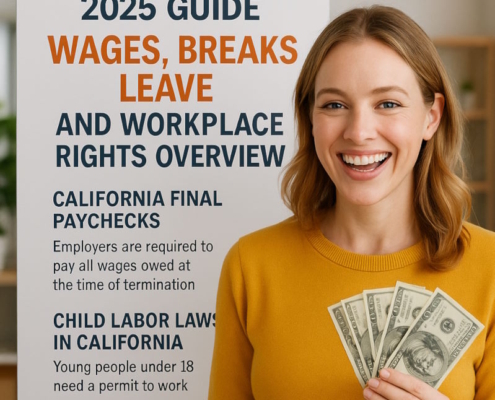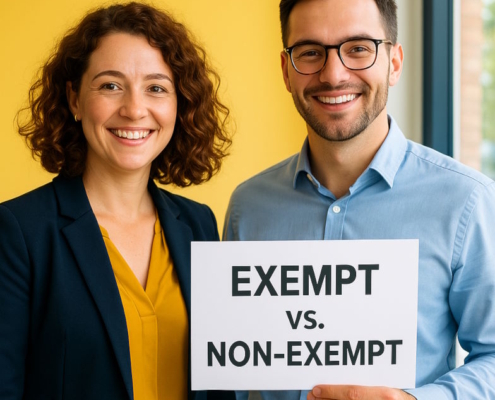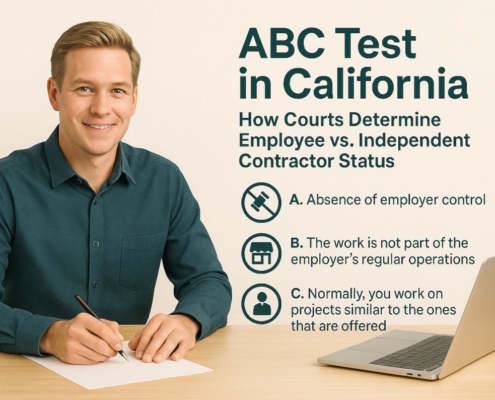1. Can I work 6 hours without a lunch break in California?
Under Labor Code 512, non-exempt employees who work more than 5 hours per day must receive a minimum meal break of 30 minutes. If the employee works for more than 10 hours per day, the employee must be provided a second meal break of at least 30 minutes. However, if the total work period per day of the employee is no more than six hours, the meal period may be waived by mutual consent of both the employer and employee. A second meal period of not less than thirty minutes is required if an employee works more than ten hours per day, except that if the total hours worked is no more than 12 hours, the second meal period may be waived by mutual consent of the employer and employee only if the first meal period was not waived. A meal break can be unpaid only if all of the above conditions are met.
Example: Alan is scheduled to work six hours at a retail job. Alan’s employer and Alan agree to waive his 30-minute meal break so Alan can leave earlier. This is lawful because Alan’s total work period does not exceed six hours.
2. Can I work 6 hours without a lunch break?
In California, an employer may not employ an employee for a work period of more than five hours per day without providing the employee with a meal period of not less than thirty minutes, except that if the total work period per day of the employee is no more than six hours, the meal period may be waived by mutual consent of both the employer and employee. The California Labor Code provides that employees who work more than five (5) hours in a day are entitled to a thirty (30) minute meal break. If the employee is working no more than six (6) hours in a day, the employee may waive their meal break. Unless the employee is relieved of all duty during his or her thirty minute meal period, the meal period shall be considered an “on duty” meal period that is counted as hours worked which must be compensated at the employee’s regular rate of pay. Employers must provide an unpaid, off-duty meal period of at least 30 minutes if the work period exceeds five hours.
Example: Maria works a six-hour shift in a bakery. Her employer informs her of her right to a meal break, but Maria agrees to waive it. This decision complies with California labor laws.
3. Do you have to take a lunch if you work 6 hours?
When a work period of not more than six hours will complete the day’s work, the meal period may be waived by mutual consent of the employer and the employee. Employers cannot discourage or impede employees from taking their meal breaks, but employees can voluntarily waive them under certain conditions. If the employee’s shift is greater than ten hours, but will not exceed 12 hours, they can waive their right to a second meal break as long as they take the first meal break. Employers must put up meal breaks, but do not have to ensure employees take those breaks. A suitable sheltered place must be provided in which to consume such food or drink.
Example: Sarah works a six-hour shift at a grocery store. She chooses to waive her meal break to leave early, and her employer agrees. This arrangement is consistent with California labor law, as the waiver was mutual and voluntary.
4. Do I need to take a lunch if I work 6 hours?
Employers cannot discourage or impede employees from taking their meal breaks, but employees can voluntarily waive them under certain conditions. A meal break can be waived if the employee is working no more than 6 hours in a day. However, an employee cannot waive his or her lunch break if the employee is working 6 or more hours in a day, even if they are not getting paid for the break. A second meal period of not less than thirty minutes is required if an employee works more than ten hours per day, except that if the total hours worked is no more than 12 hours, the second meal period may be waived by mutual consent of the employer and employee only if the first meal period was not waived. If the total work period per day of the employee is no more than six hours, the meal period may be waived by mutual consent of both the employer and employee.
Example: John works from 8:00 a.m. to 2:00 p.m. and agrees with his employer to waive his lunch break. Since his total work period does not exceed six hours, this decision complies with the law.
5. If I work 6 hours, do I get a lunch?
Non-exempt employees working more than five hours in a day are entitled to a 30-minute meal break, though it can be waived for shifts of six hours or less. An employee who is not relieved of all duty during his or her lunch break is still considered “on duty.” This includes employees who are relieved of all duties but must remain on the work site. An “on duty” meal period is counted as hours worked and must be compensated at the employee’s standard rate of pay. “On duty” lunch breaks are only permitted when the nature of the job prevents the employee from being relieved of all duties and by written agreement. Employers cannot require employees to remain on-site or on-call during rest breaks.
Example: Anna works a six-hour shift at a retail store. Her employer provides the opportunity for a meal break, but Anna waives it with mutual agreement. This decision adheres to California labor laws.
6. If I work 6 hours, what is my break?
California requires employers to provide a 10-minute uninterrupted, duty-free rest break for every four hours worked or major fraction thereof. Rest breaks must to the extent possible be in the middle of each work period. If you work at least 3.5 hours in a day, you are entitled to one rest break. If you work over 6 hours, you are entitled to a second rest break. Rest breaks must be paid and must be taken during the workday.
Example: Lisa works a six-hour shift at a warehouse. She takes her 10-minute rest break but waives her 30-minute meal break. Her employer complies with California law by ensuring she receives her rest break.
7. Do you have to take a break if you work 6 hours?
Employers must authorize and permit uninterrupted rest breaks for all nonexempt employees whose total daily work time is at least 3.5 hours. These mandatory rest breaks must be offered at the rate of 10 minutes for every four hours worked, or “major fraction” thereof. Employers cannot require employees to remain on-site or on-call during rest breaks. If the employer requires the employee to remain at the work site or facility during the meal period, the meal period must be paid. If either rest break is not given or is interrupted, you owe the employee one hour of pay at the regular rate of pay.
Example: David works six hours as a cashier and takes a 10-minute rest break. His employer ensures he is relieved of all duties during the break, complying with California labor laws.
8. If I work 6 hours, how many breaks do I get?
If you work over 6 hours, you are entitled to a second rest break in addition to the 30-minute meal break. Employees are entitled to a ten-minute rest break for every four hours worked or major fraction thereof. Nonexempt employees who work less than three-and-a-half hours are not entitled to rest breaks. Employers must treat rest periods as hours worked and must pay rest periods as time worked. Employers may face penalties for noncompliance, including additional pay for missed breaks.
Example: Emma works a six-hour shift at a grocery store. She takes one 10-minute rest break and waives her meal break to finish her shift early. Her employer ensures compliance with the law by providing her rest break.
Key Points
California labor laws ensure employees working six-hour shifts have clear rights to meal and rest breaks. Non-exempt employees are entitled to a 30-minute meal break if they work more than five hours, though this break can be waived if their total work period does not exceed six hours. Employers must also provide a 10-minute paid rest break for every four hours worked. Employers who fail to meet these obligations may be subject to penalties, including additional pay for each missed break.































